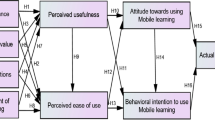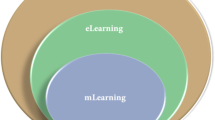Abstract
Due to the rapid development of mobile technologies, the perceptions and acceptance relating to mobile learning have been changing over the last few decades. The concepts surrounding these two factors seem to be undetermined and incomprehensible for many EFL teachers and learners. The purpose of this study was to investigate the perceived perceptions and perceived acceptance on mobile learning (M-learning) held by university EFL instructors and students. Two sets of questionnaires were developed, piloted and refined, and then were administered to 52 instructors and 319 students from various universities throughout Taiwan. Statistical analysis of the data included descriptive data, t test, and a one-way ANOVA. The results indicated that both the instructors and students had high levels of perception and acceptance toward M-learning for EFL. A positive relationship between perception and acceptance was perceived with the level of perception positively associated with the acceptance of M-learning. Analysis of the results indicated significant differences in terms of participants’ background characteristics. Most notably, the younger the instructor, the higher the level of perception and acceptance of M-learning. Finally, several pedagogical implications were made toward M-learning and it is the responsibility of the EFL educators to integrate M-learning into their classrooms and made M-learning available for their students.
Similar content being viewed by others
References
Abu-Al-Aish, A., Love, S.: Factors influencing students’ acceptance of m-learning: an investigation in higher education. Int. Rev. Res. Open Distance Learn. 14(5), 82–107 (2013)
Amin, A., Mahmood, A., Abidin, A., Rahman, M.: M-learning management tool development in campus-wide environment. Issues Informing Sci. Inf. Technol. 3, 423–434 (2006)
Baran, E.: A review of research on mobile learning in teacher education. Educ. Technol. Soc. 17, 417–432 (2014)
Burston, J.: Twenty years of MALL project implementation: a meta-analysis of learning outcomes. Recall 27(1), 4–20 (2015). doi:10.1017/S0958344014000159
Chen, C.M., Chung, C.J.: Personalized mobile English vocabulary learning system based on item response theory and learning memory cycle. Comput. Educ. 51(2), 624–645 (2008). doi:10.1016/j.compedu.2007.06.011
Chen, C.M., Hsu, S.H.: Personalized intelligent mobile learning system for supporting effective English learning. Educ. Technol. Soc. 11(3), 153–180 (2008)
Cheon, J., Lee, S., Crooks, S.M., Song, J.: An investigation of mobile learning readiness in higher education based on the theory of planned behavior. Comput. Educ. 59(3), 1054–1064 (2012). doi:10.1016/j.compedu.2012.04.015
Cui, Y., Bull, S.: Context and learner modelling for the mobile foreign language learner. System 33(2), 353–367 (2005). doi:10.1016/j.system.2004.12.008
Dye, A., Solstad, B.E.K., Odingo, J.A.: Mobile education—a glance at the future. Retrieved from http://nettskolen.nki.no/forskning/mobile_education.pdf (2003)
García-Peñalvo, F.J., Conde, M.Á.: The impact of a mobile personal learning environment in different educational contexts. Univ. Access Inf. Soc. 14(3), 375–387 (2015). doi:10.1007/s10209-014-0366-z
Gikas, J., Grant, M.M.: Mobile computing devices in higher education: student perspectives on learning with cellphones, smartphones & social media. Internet High. Educ. 19, 18–26 (2013). doi:10.1016/j.iheduc.2013.06.002
Gromik, N.A.: Cell phone video recording feature as a language learning tool: a case study. Comput. Educ. 58(1), 223–230 (2012). doi:10.1016/j.compedu.2011.06.013
Hsu, C.K., Hwang, G.J., Chang, C.K.: A personalized recommendation-based mobile learning approach to improving the reading performance of EFL students. Comput. Educ. 63, 327–336 (2013). doi:10.1016/j.compedu.2012.12.004
Hsu, L.: English as a foreign language learners’ perception of mobile assisted language learning: a cross-national study. Comput. Assist. Lang. Learn. 26(3), 197–213 (2013). doi:10.1080/09588221.2011.649485
Huang, Y.M., Huang, Y.M., Huang, S.H., Lin, Y.T.: A ubiquitous English vocabulary learning system: evidence of active/passive attitudes vs. usefulness/ease-of-use. Comput. Educ. 58(1), 273–282 (2012). doi:10.1016/j.compedu.2011.08.008
Jia, J., Chen, Y., Ding, Z., Ruan, M.: Effects of a vocabulary acquisition and assessment system on students’ performance in a blended learning class for English subject. Comput. Educ. 58(1), 63–76 (2012). doi:10.1016/j.compedu.2011.08.002
Jokela, T., Koivumaa, J., Pirkola, J., Salminen, P., Kantola, N.: Methods for quantitative usability requirements: a case study on the development of the user interface of a mobile phone. Pers. Ubiquit. Comput. 10(6), 345–355 (2006). doi:10.1007/s00779-005-0050-7
Ke, F., Hsu, Y.C.: Mobile augmented-reality artifact creation as a component of mobile computer-supported collaborative learning. Internet High. Educ. 26, 33–41 (2015). doi:10.1016/j.iheduc.2015.04.003
Keegan, D.: The Future of Learning: From E-Learning to M-Learning. Fern Universität, Gesamthochschule, Hagen (2002)
Khwaileh, F.M., AlJarrah, A.A.: Graduate students’ perceptions toward mobile-learning (M-learning) at the University of Jordan. Instr. Technol. 7(10), 15–23 (2010)
Kim, D., Rueckert, D., Seo, D., Kim, D.: Student’s perceptions and experiences of mobile learning. Lang. Learn. Technol. 17(3), 52–73 (2013)
Kukulska-Hulme, A.: How should the higher education workforce adapt to advancements in technology for teaching and learning? Internet High. Educ. 15(4), 247–254 (2012). doi:10.1016/j.iheduc.2011.12.002
Martin-Dorta, N., Saorin, J.L., Contero, M.: Web-based spatial training using handheld touch screen devices. Educ. Technol. Soc. 14(3), 163–177 (2011)
Mnaathr, S.H., Basha, A.D., Mohain, A.R., Jamaludin, R.: Investigating and finding the attitudes and self efficiency of learners in Iraqi higher education by using portable devices. Int. J. Eng. Res. Dev. 6(12), 112–118 (2013)
Najimi, A., Lee, J. (2009). Why and how mobile learning can make a difference in the K-16 classroom? Paper presented at the Society for Information Technology and Teacher Education International Conference, Chesapeake, VA
O’ Malley, C., Vavoula, G., Glew, J.P., Taylor, J., Sharples, M., Lefrere, P.: MobiLearn: WP-Guidelines for Learning/Teaching/Tutoring in a Mobile Environment. Retrieved from http://www.mobilearn.org/download/results/guidelines.pdf (2003)
Ott, M.: School of the future: E-tools and new pedagogies to build up an inclusive learning community. In: Ordóñez de Pablos, P. (ed.) Technology Enhanced Learning for People with Disabilities: Approaches and Applications: Approaches and Applications, pp. 105–120. Information Science Reference (2010). doi:10.4018/978-1-61520-923-1
Parmaxi, A., Zaphiris, P., Papadima-Sophocleous, S., Ioannou, A.: Mapping the landscape of computer-assisted language learning: an inventory of research. Interact. Technol. Smart Educ. 10(4), 252–269 (2013)
Proctor, M.D., Marks, Y.: A survey of exemplar teachers’ perceptions, use, and access of computer-based games and technology for classroom instruction. Comput. Educ. 62, 171–180 (2013). doi:10.1016/j.compedu.2012.10.022
Rau, P.L.P., Gao, Q., Wu, L.M.: Using mobile communication technology in high school education: motivation, pressure, and learning performance. Comput. Educ. 50(1), 1–22 (2008). doi:10.1016/j.compedu.2006.03.008
Sandberg, J., Maris, M., De Geus, K.: Mobile English learning: an evidence-based study with fifth graders. Comput. Educ. 57(1), 1334–1347 (2011). doi:10.1016/j.compedu.2011.01.015
Santos, I.M., Ali, N.: Exploring the uses of mobile phones to support informal learning. Educ. Inf. Technol. 17(2), 187–203 (2012). doi:10.1007/s10639-011-9151-2
Sharples, M.: The design of personal mobile technologies for lifelong learning. Comput. Educ. 34(3–4), 177–193 (2000). doi:10.1016/S0360-1315(99)00044-5
Stockwell, G.: Using mobile phones for vocabulary activities: examining the effect of the platform. Lang. Learn. Technol. 14(2), 95–110 (2010)
Tan, T.H., Liu, T.Y.: The mobile-based interactive learning environment (MOBILE) and a case study for assisting elementary school English learning. In: Proceedings of the 2004 IEEE International Conference on Advanced Learning Technologies. Los Alamitos, CA: IEEE Computer Society. Retrievable from http://ieeexplore.ieee.org (2004)
Thomas, K.M., O’Bannon, B.W., Britt, V.G.: Standing in the schoolhouse door: teacher perceptions of mobile phones in the classroom. J. Res. Technol. Educ. 46(4), 373–395 (2014). doi:10.1080/15391523.2014.925686
Thornton, P., Houser, C.: M-learning: Learning in transit. In: Lewis, P. (ed.) The Changing Face of Call: A Japanese Perspective, pp. 229–243. Swets & Zeitlinger, Lisse (2002)
Thornton, P., Houser, C.: Using mobile phones in English education in Japan. J. Comput. Assist. Learn. 21(3), 217–228 (2005). doi:10.1111/j.1365-2729.2005.00129.x
Union IT: ITU releases 2014 ICT figures. Retrieved from http://www.itu.int/en/ITU-D/statistics/Pages/default.aspx (2014)
Viberg, O., Grönlund, Å.: Cross-cultural analysis of users’ attitudes toward the use of mobile devices in second and foreign language learning in higher education: a case from Sweden and China. Comput. Educ. 69, 169–180 (2013). doi:10.1016/j.compedu.2013.07.014
Wang, M.J.: Web based projects enhancing English language and generic skills development for Asian hospitality industry students. Aust. J. Educ. Technol. Soc. 25(5), 611–626 (2009)
Woukeu, A., Millard, D.E., Tao, F., Davis, H.C.: Challenges for semantic grid based mobile learning. Paper Presented at the IEEE SITIS Conference, Yaounde, Cameroon (2005)
Wu, W.H., Wu, Y.C., Chen, C.Y., Kao, H.Y., Lin, C.H., Huang, S.H.: Review of trends from mobile learning studies: a meta-analysis. Comput. Educ. 59(2), 817–827 (2012). doi:10.1016/j.compedu.2012.03.016
Acknowledgments
This work was supported by the Ministry of Science and Technology in Taiwan under Grant MOST103-2410-H-324-012.
Author information
Authors and Affiliations
Corresponding author
Appendix
Appendix
See Table 7.
Rights and permissions
About this article
Cite this article
Chen, K.TC. Examining EFL instructors’ and students’ perceptions and acceptance toward M-learning in higher education. Univ Access Inf Soc 16, 967–976 (2017). https://doi.org/10.1007/s10209-016-0494-8
Published:
Issue Date:
DOI: https://doi.org/10.1007/s10209-016-0494-8




